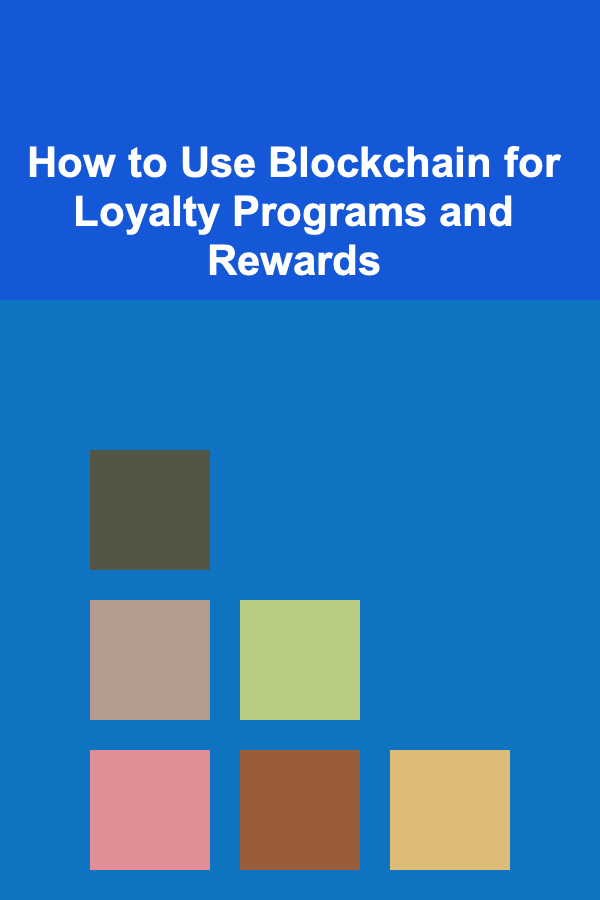
How to Use Blockchain for Loyalty Programs and Rewards
ebook include PDF & Audio bundle (Micro Guide)
$12.99$10.99
Limited Time Offer! Order within the next:

In the age of digital transformation, businesses are constantly seeking innovative ways to build stronger relationships with their customers. Loyalty programs have long been a popular tool for rewarding customers and fostering brand loyalty. However, as technology evolves, traditional loyalty programs are starting to show their limitations. Enter blockchain technology, a game-changing innovation that promises to enhance loyalty programs in ways that were previously unimaginable.
Blockchain, originally designed as the underlying technology for cryptocurrencies like Bitcoin, is now finding applications in a wide variety of industries. One of the most promising areas of application is in loyalty programs and rewards systems. In this article, we will explore how businesses can use blockchain for loyalty programs and rewards, the benefits it offers, and the challenges it presents.
What is Blockchain?
Before diving into the use of blockchain in loyalty programs, it's important to understand what blockchain is. Simply put, blockchain is a decentralized and distributed ledger technology that allows data to be stored across multiple computers in a secure and transparent way. Each block in a blockchain contains a record of transactions, and once a block is added to the chain, it is nearly impossible to alter or delete. This immutability is what makes blockchain so secure and trustworthy.
Unlike traditional centralized databases, blockchain operates on a peer-to-peer network, meaning that there is no central authority controlling the system. Instead, the participants (or nodes) in the network collectively validate and record transactions. This makes blockchain highly resilient to hacking and fraud, which is why it is seen as an ideal solution for managing sensitive data such as customer loyalty points.
Challenges with Traditional Loyalty Programs
Before we delve into how blockchain can improve loyalty programs, it's important to highlight the challenges faced by traditional loyalty systems:
1. Fragmentation
Many businesses have their own loyalty programs, but these programs are often siloed, meaning that customers are forced to keep track of multiple loyalty points across different companies. This creates a fragmented experience and limits the flexibility of how loyalty points can be used.
2. Security Concerns
Traditional loyalty programs rely on centralized databases, making them vulnerable to hacking. If a centralized system is compromised, customer data---including loyalty points---can be stolen or manipulated.
3. Limited Interoperability
Since most loyalty programs are proprietary, there is little to no interaction between programs. For example, you can't typically use points earned from one retailer at another business, which makes loyalty points less valuable and less appealing to customers.
4. Inefficiencies
The management of loyalty programs can be resource-intensive, requiring manual tracking and management of points, redemptions, and rewards. This creates operational inefficiencies and can lead to errors in reward distribution.
5. Fraud and Abuse
Because traditional loyalty programs rely on central databases and systems, they are susceptible to fraud and abuse. Fraudsters can exploit loopholes to manipulate the system, generating points through illegal means.
How Blockchain Solves These Issues
Blockchain technology can address the problems faced by traditional loyalty programs by offering a decentralized, transparent, and secure way to track and manage loyalty points and rewards. Here's how blockchain can enhance loyalty programs:
1. Interoperability
With blockchain, loyalty points can be tokenized as digital assets, allowing them to be exchanged across different businesses and platforms. This enables a seamless and unified loyalty program that transcends individual companies. Customers can accumulate and redeem loyalty points from various brands within a blockchain-based ecosystem, significantly increasing the value and utility of the points.
For example, a customer might earn loyalty points from a coffee shop, which can then be used to purchase items at a partner retailer, such as a clothing store. This interoperability makes loyalty programs more attractive to customers, as they can use their points more flexibly.
2. Enhanced Security and Transparency
Blockchain's inherent security features make it ideal for loyalty programs. Each transaction is recorded in a block, and the data is distributed across the network, ensuring that no single party has control over the entire system. This decentralized nature makes it difficult for malicious actors to alter or manipulate the data, significantly reducing the risk of fraud and hacking.
Additionally, the transparency of blockchain means that customers can track their loyalty points in real-time, seeing how many points they have earned, when they were earned, and how they can be redeemed. This level of transparency builds trust and confidence in the system.
3. Reduced Costs and Operational Efficiencies
Blockchain can automate many of the processes involved in managing loyalty programs, such as tracking points, issuing rewards, and handling redemptions. Smart contracts---self-executing contracts with the terms of the agreement directly written into code---can be used to automate these tasks, reducing the need for manual intervention and minimizing human error.
Smart contracts can also help businesses reduce transaction fees and administrative costs by cutting out intermediaries and streamlining the loyalty program's backend operations.
4. Decentralized Control
By using a blockchain-based loyalty system, businesses can avoid the need for a centralized database or third-party intermediary. This reduces the risk of data breaches and ensures that customer data is not held by a single entity. Customers maintain greater control over their loyalty points, which are stored securely in digital wallets.
5. Fraud Prevention
Blockchain's immutable ledger makes it nearly impossible for fraudsters to manipulate the system. Since every transaction is recorded on the blockchain, it is easy to trace any fraudulent activity and prevent it from occurring in the first place. This greatly reduces the chances of loyalty point manipulation or abuse, offering a more reliable and secure experience for both businesses and customers.
Key Benefits of Using Blockchain for Loyalty Programs
1. Improved Customer Experience
By offering a more flexible, secure, and transparent loyalty program, businesses can significantly improve the customer experience. Customers will appreciate the ability to earn and redeem points across a wide range of businesses, as well as the peace of mind that comes from knowing their points are safe from fraud.
2. Increased Customer Retention
A blockchain-powered loyalty program can encourage greater customer engagement and retention. When customers can easily track their points and redeem them for valuable rewards, they are more likely to continue doing business with the company. Additionally, the ability to transfer or exchange loyalty points with other businesses adds a new layer of value to the program, further incentivizing customers to stay loyal.
3. Cost Savings for Businesses
Blockchain-based loyalty programs can reduce costs by automating many of the processes involved in managing points and rewards. This means businesses can allocate more resources to customer engagement and marketing rather than administrative tasks.
4. Greater Customer Trust
With the transparency and security that blockchain offers, customers are more likely to trust the loyalty program. Blockchain's decentralized nature means that customers can verify the legitimacy of their points and rewards, which builds trust and confidence in the system.
5. New Revenue Streams
Blockchain opens up the potential for new revenue streams. For example, businesses could monetize their loyalty programs by allowing third-party companies to purchase or exchange loyalty points. This could create a new ecosystem where customers have even more ways to use their points.
Real-World Examples of Blockchain in Loyalty Programs
Several companies are already exploring the potential of blockchain to enhance their loyalty programs. Below are some examples of how blockchain is being used in the real world:
1. LoyaltyLion
LoyaltyLion is a blockchain-powered loyalty program that allows businesses to create custom loyalty schemes for their customers. Using blockchain, LoyaltyLion enables the tokenization of loyalty points, making them easily transferable and redeemable across a range of platforms. Customers can earn points for actions such as making purchases, referring friends, and engaging with the brand on social media.
2. BitRewards
BitRewards is a blockchain-based loyalty platform that allows businesses to reward customers with cryptocurrency-based loyalty points. These points can be redeemed for discounts, products, or even exchanged for other cryptocurrencies. BitRewards aims to create a decentralized loyalty network that empowers both customers and businesses.
3. Swipe
Swipe is a blockchain-based loyalty program that lets customers earn reward points in the form of cryptocurrency. Customers can redeem their points for products, services, or convert them into traditional currencies. The platform uses blockchain to ensure transparency, security, and real-time tracking of loyalty points.
Challenges and Considerations
While blockchain offers many benefits, there are also challenges that businesses must consider when implementing blockchain-based loyalty programs:
1. Adoption and Integration
One of the main challenges is the adoption of blockchain technology, both by businesses and customers. Many customers may not be familiar with blockchain or cryptocurrencies, which could limit the effectiveness of the loyalty program. Additionally, businesses may face challenges integrating blockchain with their existing systems and platforms.
2. Regulatory Concerns
Blockchain technology is still relatively new, and there are regulatory uncertainties surrounding its use, especially when it comes to cryptocurrency-based rewards. Businesses must ensure they comply with local regulations regarding cryptocurrency, data protection, and financial transactions.
3. Scalability
As the number of participants in a blockchain-based loyalty program grows, the system must be able to handle increased transaction volume. Ensuring that the blockchain platform is scalable and can handle large amounts of data is critical for the success of the program.
4. Customer Education
For blockchain-based loyalty programs to succeed, businesses must educate their customers about how the program works and the benefits of using blockchain for loyalty. Without proper education, customers may be hesitant to participate in the program.
Conclusion
Blockchain has the potential to revolutionize loyalty programs by offering greater transparency, security, and flexibility. By leveraging blockchain technology, businesses can create more effective and customer-friendly loyalty programs that drive engagement, increase retention, and reduce costs. However, businesses must carefully consider the challenges associated with blockchain adoption, integration, and scalability. If done correctly, blockchain-powered loyalty programs can offer a competitive edge and create a more rewarding experience for both customers and businesses alike.
Reading More From Our Other Websites
- [Home Budget 101] How to Use Budgeting Apps and Tools to Manage Your Home Finances Effectively
- [Personal Investment 101] How to Set Financial Goals and Align Your Investments with Them
- [Personal Finance Management 101] How to Set Realistic Financial Goals Based on Your Income
- [Home Budget Decorating 101] How to Upgrade Your Home's Curb Appeal on a Budget
- [Personal Investment 101] Turn Deep Learning Knowledge into Profits with AI-Powered Products
- [Small Business 101] How to Build a Community‑Driven Loyalty Program for Independent Bookstores
- [Organization Tip 101] How to Teach Kids About Holiday Decoration Traditions
- [Home Party Planning 101] How to Create a Unique Guest List That Fits Your Party Style
- [Scrapbooking Tip 101] Time-Saving Scrapbooking Hacks Every DIY Enthusiast Needs
- [Toy Making Tip 101] From Concept to Creation: Essential Tools for Crafting Handmade Toys

How to Create a Backup of Your Recipe Collection
Read More
How to Track and Measure the Success of Your Investments Over Time
Read More
How To Practice Coding Challenges Daily: A Comprehensive Guide
Read More
How to Track College Application Fees and Expenses
Read More
How to Secure Your Mobile App from Common Threats
Read More
10 Tips for Social Media Planning with Limited Resources
Read MoreOther Products

How to Create a Backup of Your Recipe Collection
Read More
How to Track and Measure the Success of Your Investments Over Time
Read More
How To Practice Coding Challenges Daily: A Comprehensive Guide
Read More
How to Track College Application Fees and Expenses
Read More
How to Secure Your Mobile App from Common Threats
Read More